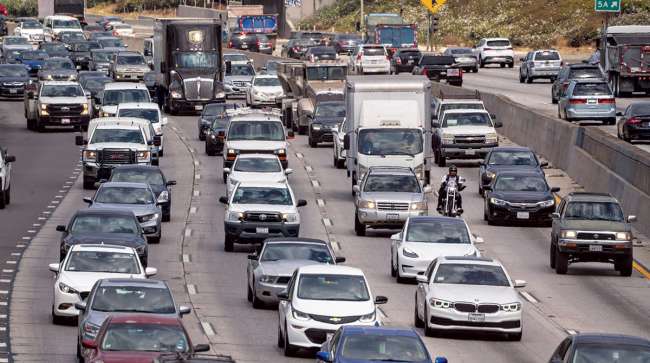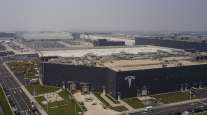Los Angeles Times
California Seeks to Ban Sales of Diesel Big Rigs by 2040

[Stay on top of transportation news: Get TTNews in your inbox.]
Saying they had a “moral obligation,” California regulators could soon ban the sale of diesel big rigs by 2040.
The proposal by staff of the California Air Resources Board would further require that, by 2035, medium- and heavy-duty trucks entering ports and railyards must be zero emission and that state and local government fleets be so by 2027.
The new regulations would likely demand a radical buildup of electric charging infrastructure, placing new stresses on California’s already fragile power grid and force the trucking industry to reshape how it does business. Regulators and activists say any disruption would ultimately be outweighed by lives and money saved.
“Pound for pound, heavy-duty trucks are putting out far more pollution than anything else on the road,” said Will Barrett, national senior director for clean air advocacy with the American Lung Association. “And that’s really directly contributing to the fact that California has the worst air pollution in the country.”
The proposal follows last month’s vote by the board to end the sale of new gas-powered passenger cars and light trucks by 2035, citing an urgent need to combat human-caused climate change. The combination of measures puts heavy pressure on manufacturers and policymakers to move more swiftly toward emission-free vehicles.
The California Air Resources Board, which must vote on the truck proposal, is expected to consider it Oct. 27.
Many who rely on the trucks for work or commerce are worried the state isn’t ready for such a quick transformation.
“There is no infrastructure to support this,” said Chris Shimoda, vice president of the California Trucking Association.

Shimoda
Even if California built up the charging infrastructure starting today, he said it’s unlikely that there would be enough to support the 400,000 big rigs traveling up and down the state by the deadline.
There are already 1,900 medium- and heavy-duty zero-emission vehicles operating in California, most of which are transit buses.
“It would be the next significant step in accelerating towards a zero-emission transportation system as well as a more equitable future in California,” the proposal said.
Trucks are the largest source of nitrogen oxide emissions in California. State air regulators wrote they had “legal and moral obligations” to lessen the pollution big rigs and other trucks leave in the most vulnerable communities, adding that the changes could significantly cut the amount of greenhouse gas.
Under the proposed regulations, large fleet operators such as Amazon, Walmart and other companies would also convert all their trucks operating in the state to zero-emission vehicles by 2042.
Regulators estimate these moves, which would target all fossil-fuel-powered big rigs, would save 5,000 Californian lives between 2024 and 2050 by preventing premature deaths, and reduce health costs by $57 billion.
Lower-income communities of color face disproportionate health impacts from trucking, including increased risk for cancers and heart attacks, from diesel particulates as they are often the groups living near major freeways, warehouses, ports, railyards and other places where trucks collect, Barrett said.
Those environmental inequities were a critical consideration in the board’s push toward zero emissions.
“Decades of racist and classist practices, including redlining and siting decisions, have concentrated heavy-duty vehicle and freight activities in these communities, with concomitant disproportionate pollution burdens,” the regulators said in their proposed rules.
“The rule truly is monumental. This is the only way we can get diesel out of our community,” said Andrea Vidaurre, a policy analyst at the People’s Collective for Environmental Justice, a nonprofit based in the Inland Empire.
The region is the heart of the nation’s distribution centers, where Amazon is building one of its largest warehouses and thousands of trucks come and go daily, often passing through residential areas.
Want more news? Listen to today's daily briefing above or go here for more info
Shimoda, of the trucking association, said regulators had not thought through the consequences of their timeline.
Often the fastest big rig charging stations take three to four hours, precious time when truckers are waiting for deliveries. Fast chargers take a shorter time but suck up immense levels of energy that could strain the power grid, especially during Flex Alerts.
In its own analysis, the resources board acknowledged the importance of an “extreme high-powered charging system” that would reduce vehicle charge times to less than an hour, but noted that the technology is still in development.
“That’s not going to work given how overly strained the supply chain is,” Shimoda said. “We don’t have an answer for that issue right now.”
Distributed by Tribune Content Agency, LLC




